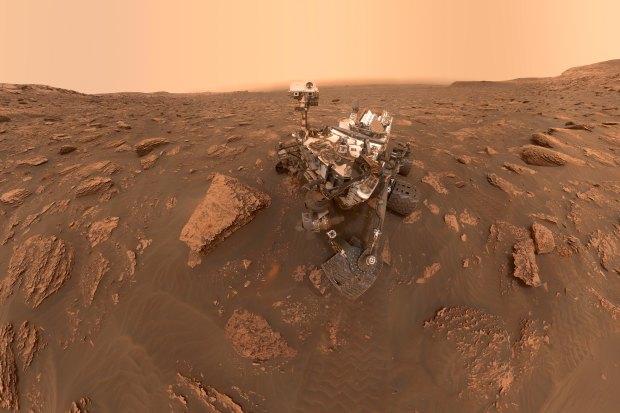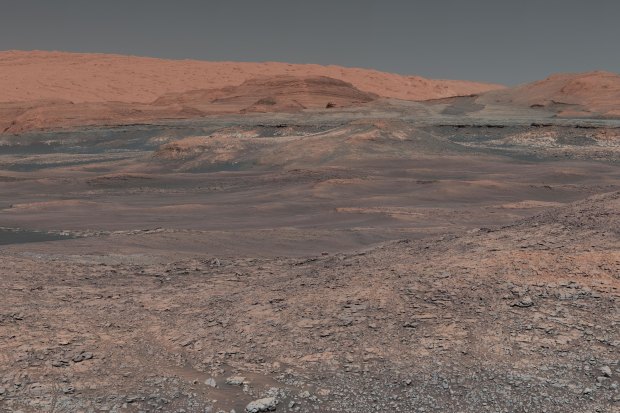Explainer
- Explainer
- Space
Why are so many nations blasting off to Mars?
While international travel is largely grounded, interplanetary travel is enjoying a moment of its own. Why are nations heading to the red planet? And when will humans follow?
For the past eight years, scientists have been driving a nuclear-powered robot the size of a car across the surface of Mars. While it’s not the first to touch down, NASA’s Curiosity rover is the last still manning its post on a planet now littered with the skeletons of failed or expired missions.
But it’s about to get some company.
In July, three new rockets blasted off for the red planet – the United States has sent its next NASA rover, Perseverance, to hunt for signs of life and pave the way for human explorers; China will land its first rover on Mars along with a host of other gear, also to search for life; and the United Arab Emirates will fly a probe into Martian orbit to measure the planet's atmosphere, in the Middle East’s first interplanetary mission.
As a new space race heats up, ambitions have moved beyond the moon to the red planet. This time, it’s about more than flying a flag, says astrophysicist Brad Tucker at the Australian National University. Finding life on another planet would be one of humanity’s greatest discoveries, transforming our understanding of not only the universe but life on Earth.
And then there are the riches promised by the burgeoning space industry, in everything from rare minerals to real estate. The Trump administration has already ordered NASA to land the first humans on Mars by 2033 and tech billionaire Elon Musk has even loftier plans to set up a self-sustaining Martian city within 30 years. While Australia has no official plans for space missions as yet, its new space agency is helping NASA develop technology that can be tested by humans on the moon as a launchpad to Mars.
But why are so many Mars missions taking off in the same month – and during a pandemic? What will they do once they get there? And what’s next for humans and the red planet?

NASA rover Curiosity takes a selfie via a camera on the end of its robotic arm at Gale Crater on Mars. This panorama is made up of 57 individual images stitched together.Credit: NASA
Why the rush on Mars now?
Planning a trip to Mars comes down to some tricky celestial geometry. As the fourth rock out from the Sun, Mars takes nearly twice as long as Earth to complete its orbit around the star (687 days to our 365). That means the two planets are rarely in the same corner of the solar system for long.
But every two years or so, the two planets align at their closest point – about 57 million kilometres apart, compared with more than 200 million kilometres at their furthest.
“Imagine two cars going around a racetrack,” Tucker says. “You want both cars on the same side of the track or you have to go three or four times as far. It’s not like going to the moon, where it’s always the same distance away. Mars is a whole other ballgame.”
This window for a faster (and cheaper) run to Mars doesn’t last long and can be easily overshot if missions launch too early or too late. For the three rockets now in the skies, the journey will still take roughly seven months.
Only a handful of nations have ever reached the red planet (the US, Russia and India as well as the European Space Agency) and more than half of all missions so far have failed.
A fourth mission, jointly developed by the European Space Agency and Russia to hunt for Martian life, was due to take off in July, too, but has been grounded until the next window to Mars opens in two years because of the pandemic and further equipment testing.
Above: NASA's Ingenuity helicopter will land on Mars, with the Perseverance rover, in 2021. Source: NASA
What's NASA doing on Mars this time?
NASA’s Mars 2020 mission is step one of an ambitious plan to bring the first Martian rock samples home to Earth for testing. While past missions have looked for signs the planet is habitable, finding evidence of water underground and even past oceans on the now-barren surface, this is the first time scientists are looking for signs of life itself, says Australian Abigail Allwood, one of the lead astrobiologists on the mission.
Mars may not be the closest neighbour in our solar system, but it is the planet most like our own – and so the most likely to harbour life too.
If the Curiosity rover was designed as a laboratory on legs, Perseverance is more of a geologist, Allwood says, built to analyse and cut rock samples about the size of chalk pieces which will then be collected by a later mission, likely run by the ESA.
“When you’re on Mars, you’re limited in what you can do, but when you bring those samples back home, you have all the time and power of Earth’s laboratories to unleash on these little rocks,” Allwood says. “We are so close to getting an answer to one of the biggest questions out there, the holy grail: is there life outside our planet?”
But the $2 billion mission is not expected to find anything alive – the most likely spot to find living Martians is beneath the irradiated surface where subterranean lakes have been detected and where Allwood says it is difficult to drill.
Still, if life, even at its most microscopic level, once existed on the planet, they could find traces of it in the rocks of ancient riverbeds and lakes. The rover’s landing site, in an old lake bed known as the Jezero crater, has been carefully selected to give Perseverance the best chance.
It was in similar conditions out in the red desert of the Pilbara in Western Australia that Allwood found traces of some of the very first (microbial) life on Earth. “Back then, [3½ billion years ago], Mars was also habitable, there were lakes and rivers on the surface,” she says.
If life is found to have existed on Mars, Allwood notes it will be difficult to trace its origin, in the same way we are still to pinpoint exactly how life started on Earth. It could have been that some cross-contamination between our two planets, given their proximity, seeded life from the same source, for example a stray comet or a collision, Tucker suggests. "Or it could be that [Martian] life has a completely different origin to Earth," he says.
As for discovering intelligent or complex life, Tucker notes that finding “the boring stuff” such as microbes is much more likely but it could also be a sign there’s more out there.
“I think there’s an 80 per cent chance we find something [simple],” he says. “We keep seeing evidence of water, there’s weird changes in the gases and methane, these could just be geological but they could also be caused by life.”
Perseverance will also trial technology that could one day help human missions to Mars, including converting the carbon dioxide of the thin Martian atmosphere into oxygen. Instruments will also examine the notoriously perilous Mars landing, nicknamed the “seven minutes of terror”, to help guide future spacecraft. Because Mars has very little protective atmosphere shielding it from space, there's less to slow down an incoming lander as it speeds in to the surface – and more chance it will burn up.
If all goes to plan, a tiny helicopter about the size of a tissue box will become the first aircraft to fly these strange skies — and on another planet — after Perseverance touches down. Speaking hours ahead of the launch on July 30, Allwood says the chopper, named Ingenuity, could be a gamechanger, offering not just better views for scientists but is also scouting for a future human landing party.
And while Perseverance might not be hunting for living Martians, it does come with an on-board microphone to pick up any strange sounds or other-worldly music.
Above: The Tianwen1 blasts off. Artists' impressions show its landing. Source: CCTV
What is China's Mars mission about?
Named Tianwen1, meaning Questions to Heaven, this is China’s second go at the red planet and its most ambitious, aiming to deploy not just a rover but an orbiter and a lander too. It's hunting for signs of water and life and will survey the planet’s atmosphere.
China’s first attempt to place a probe in orbit around Mars failed in 2011, when the Russian spacecraft it hitched a ride on crashed back to Earth. But the nation has since made big strides in space using its own technology, becoming the first to touch down on the far side of the moon in 2019. In the years ahead, it plans to open its own space station in low orbit and send humans to the moon and Mars.
China’s space program is also shrouded in secrecy. Funding and specifics of such projects have not been disclosed, including the precise landing site of its Mars mission, though it is likely to touch down in the Utopia Planitia region near where NASA’s Viking 2 lander arrived in 1976. The launch of Tianwen1 on July 22 was not even broadcast live, instead appearing on state television an hour after blast-off. So far it appears to have gone without a hitch.
Above: The UAE launch of Hope. Source: Hope Mars Mission YouTube
What prompted the United Arab Emirates to go to Mars?
Now for a mission with a slightly more earthly price tag: the major maiden voyage by the UAE’s young space agency cost just $200 million — less than the budget of the film, Avengers: Endgame.
The small country drew on the expertise of other nations and tech start-ups to help its Mars mission, named Hope, blast off from Japan on July 20. It’s due to arrive at the red planet in February. The plan is to put a probe into orbit around Mars, which will produce the first Martian weather map and help answer questions such as why Mars’ atmosphere is leaking out into space. This data, including on Martian dust storms, could prove invaluable to human missions.
As space has opened up to private enterprise in the years since the original Apollo missions, Tucker says costs have fallen dramatically. India famously sent an orbiter to Mars in 2014 on a smaller budget than the film Gravity.
“It’s now literally cheaper to go into space than to make a movie about space,” Tucker says. “That means we don’t have to wait for one or two nations to take the first step and then the next step. Different people can try different things. And countries are working together too, which is beautiful. It’s not all about competition this time around, it’s about science and hey, there’s money to be made, too.”

Welcome to Mars, where Mount Sharp rises in the distance. In the middle ground are clay-bearing rocks that scientists hope will help ascertain the role of water on the planet.Credit: NASA/JPL-Caltech/MSSS
These are robots. Will humans go to Mars?
All space missions, particularly with humans on board, are expensive. But with science on the cusp of answering the question of life on Mars, Allwood says it could push forward the development of more technology to put humans on the surface.
“It may be what justifies it in the end,” she says. “Humans can do the kind of sampling no robot could ever do, so if we could get there, it could make a huge difference.”
Tucker likens our current space capabilities to “where we were in the 1940s with air travel” – a manned mission to Mars remains fraught with difficulty. “Less than half of missions now succeed – can you imagine if they had astronauts on board?
“So Mars is now that great goal like the moon was: can we do it? It’s so much harder than getting to the moon, it’s like playing rugby with your mates one afternoon and then trying the NRL. But if we can get to Mars, we can get to Europa [one of Jupiter’s largest moons]. And so on.”
NASA is already deep in planning for a human mission, estimated for the early 2030s. A crew would be gone for about three years, as they chase Earth back around the sun, but NASA says it is investigating "higher-energy propulsion technologies to shorten one leg of the trip" and so far expects the first humans may spend about 30 days on the surface of Mars.
So why do trips to the moon still matter?
Our silvery rock is “the stepping stone” to the red planet, Tucker says, both as a testing ground for technology and as a future resupply or construction site for Mars missions. The moon, locked in close orbit around the Earth, does not bring down the distance to Mars a great deal but its low gravity and tough conditions make it a good laboratory for testing the survival systems needed on the red planet. And it just happens to have water and rare metals of its own to source.
NASA's Artemis Accords, unveiled in May, propose partnerships with other nations and companies to develop the technology needed to build a sustainable (and permanent) Mars base "while preparing to conduct a historic human mission to Mars".
Australia has already pledged $150 million under the accordsfor local enterprise and research. One company, Akin Australia, is partnering with NASA to develop artificial intelligence support crews for human missions, while the Queensland University of Technology is working on software to help Allwood’s team analyse data beamed back from the rover Perseverance.
In practice, the accords mean NASA can do things such as set the price of a litre of water sourced (via ice) on the moon – and open the floor for countries and companies to snag mission contracts. It’s a vision for a new interplanetary economy where the resources needed for living, flying and construction can be mined and processed off-Earth, says Professor Alan Duffy, who heads up SpaceTech Applications at Swinburne University. This would be essential to any long-term missions to Mars and dramatically lower the cost of launching from Earth.
"This is closer than most people think,” he says.
But Duffy expects the coming wave of technology will find a use on Earth long before it reaches Mars, citing new medicines to keep astronauts healthy over many months of radiation exposure or self-repairing materials for rockets that could revolutionise aircraft in our own skies.
“The most significant advances, just as in Apollo, are ones we can’t even anticipate yet.”
Australia is already somewhat entangled in the US space program by virtue of its close defence and intelligence ties to the nation, with the CSIRO helping direct mission communications via NASA's satellites in Canberra. The deputy head of Australia’s space agency, Anthony Murfett,says the country will now leverage its competitive advantages in areas such as space medicine, communications, AI and robotics (via the mining industry) for Artemis. As Australia charts a course out of the pandemic, Murfett says the growing space sector could play an important role in its economic recovery, boosting other industries such as manufacturing and cyber.
Tucker expects Australia will launch its own rockets one day. “We want to get independent. You’d never have another country build your roads or electricity but in space, we’ve been relying on others. Still, we’re growing the industry here first, sending up more satellites.”
And what about that Martian colony?
The cold, irradiated wasteland of Mars – where temperatures can drop to minus 125 degrees – might not sound like the ideal spot to open another McDonald’s. But Elon Musk’s company, SpaceX, has a bold vision to build a self-sustaining city on the planet within the next 25 years – that's how long it calculates it will take to get in place the construction and supply bots needed (and transport enough Vitamin C tablets to the surface).
“It is a little cold,” SpaceX concedes on its website. “But we can warm it up.”
While Musk has said in recent days that costs would still need to fall dramatically for a Mars metropolis to become a reality, he says it could draw on the planet's natural resources, converting carbon dioxide, for example, into oxygen or plant fertiliser.
The UAE has also announced its intention to set up a Martian colony housing 600,000 people by 2177.
But Tucker warns the same health problems that can plague astronauts closer to home, from blood clotting to bone and vision problems, will flare up for space tourists. And then there’s the high radiation on Mars to contend with. It’s so strong that current workplace safety laws actually rule out NASA sending astronauts to Mars.
“We will start to fix and chip away at these problems, challenging questions will get us [breakthrough] solutions, but I think we will also see people realise going to Mars is not easy, and it’s probably not going to be fun,” Tucker says. “And what if we do find complex life on Mars? Are we just going to repeat [human] history and colonise it anyway?”
With Chris Zappone, video edits by Yuji Shimada

Much of Mars is covered by sand and dust but in some places, such as Holden Crater, stacks of sedimentary layers are visible.Credit: NASA/JPL-Caltech/University of Arizona
Get our Morning & Evening Edition newsletters
The most important news, analysis and insights delivered to your inbox at the start and end of each day. Sign up to The Sydney Morning Herald’s newsletter here and The Age’s newsletter here.
Let us explain
If you'd like some expert background on an issue or a news event, drop us a line at explainers@smh.com.au or explainers@theage.com.au. Read more explainers here.